

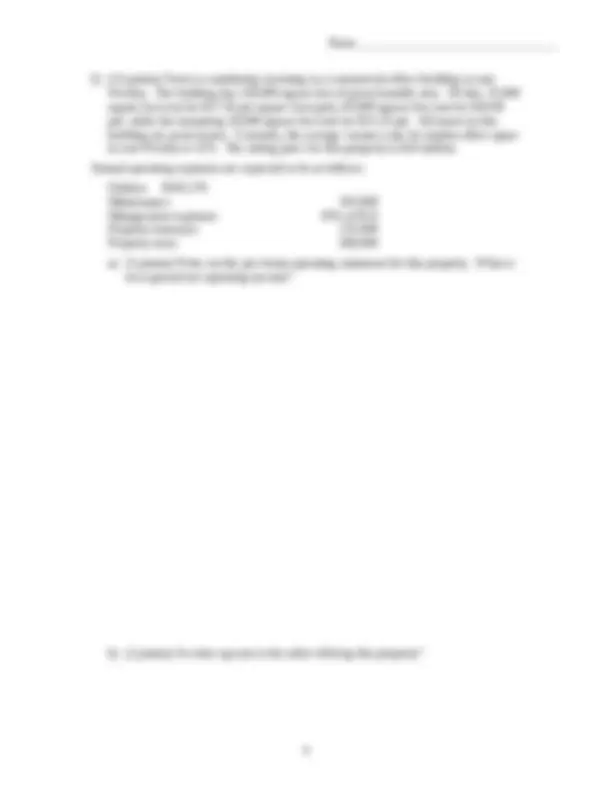
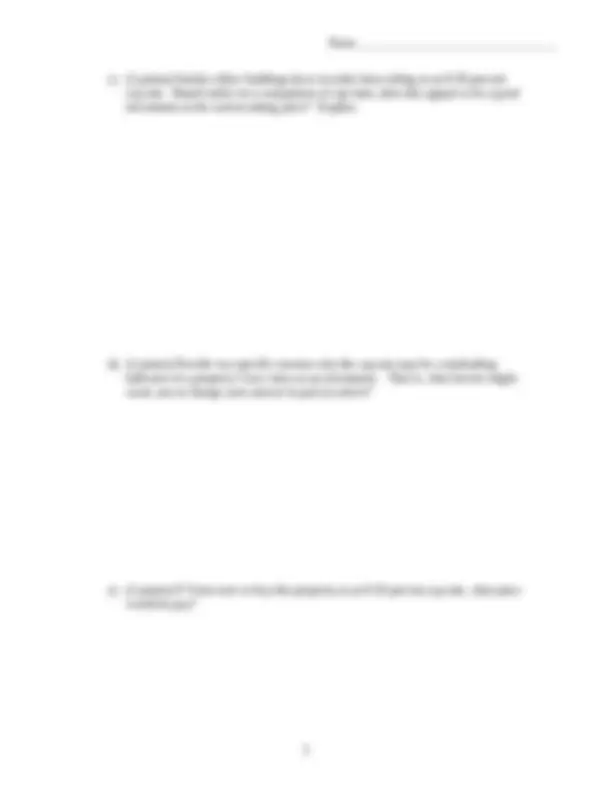
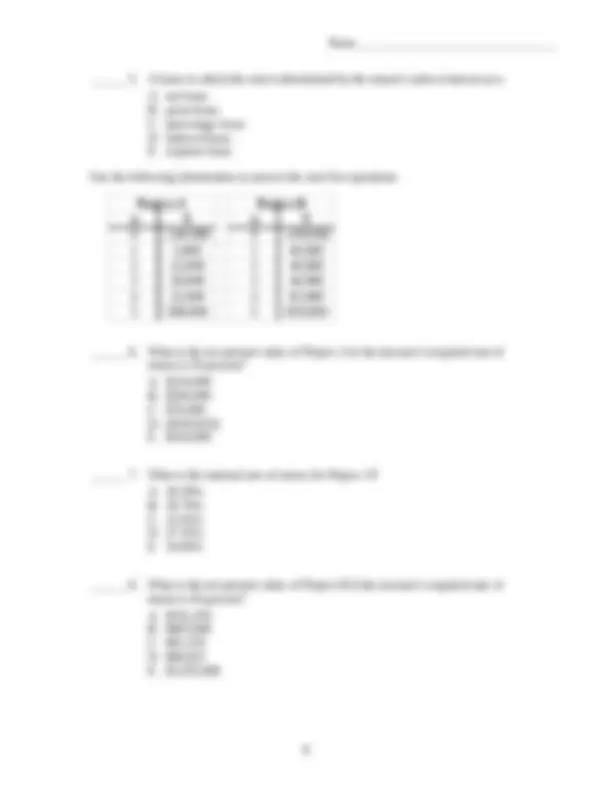
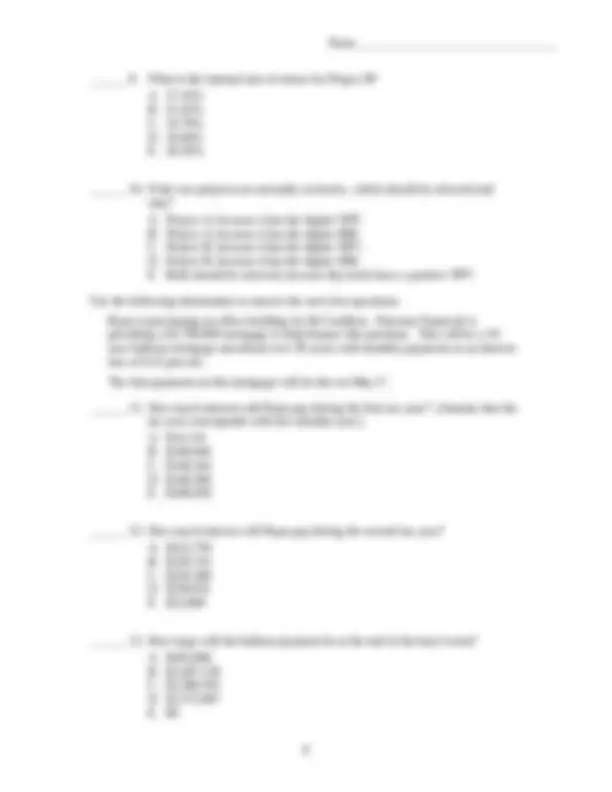
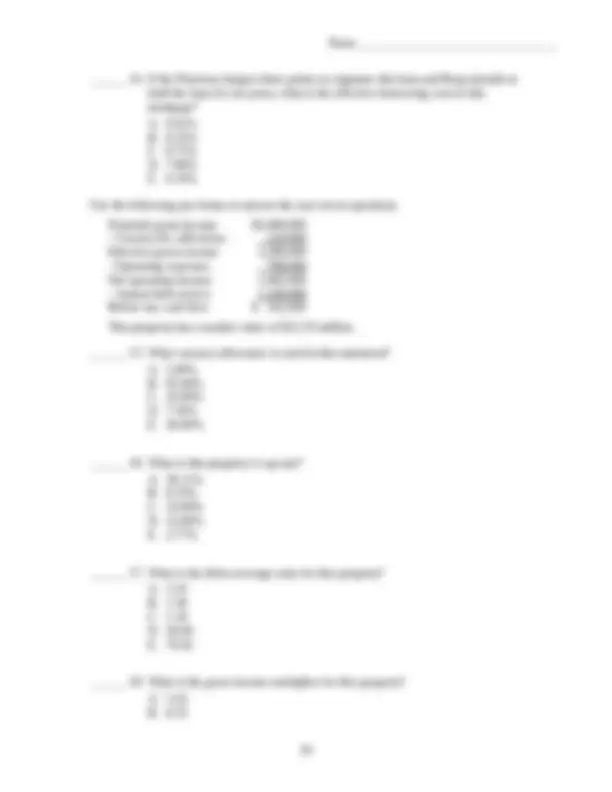


Study with the several resources on Docsity

Earn points by helping other students or get them with a premium plan


Prepare for your exams
Study with the several resources on Docsity

Earn points to download
Earn points by helping other students or get them with a premium plan
Community
Ask the community for help and clear up your study doubts
Discover the best universities in your country according to Docsity users
Free resources
Download our free guides on studying techniques, anxiety management strategies, and thesis advice from Docsity tutors
The questions and answers for the midterm exam of a real estate investment analysis course held in fall 2002. The exam covers topics such as net present value, internal rate of return, net operating income, cap rate, and loan financing. Students are required to apply these concepts to various real estate investment scenarios.
Typology: Exams
1 / 12

This page cannot be seen from the preview
Don't miss anything!







Fall 2002 Midterm Exam 1 Version A Dr. Stanley D. Longhofer Tu-Th 11:00-12: You have 1 hour and 30 minutes to complete this exam. I know its long; don’t worry, just do the best you can in the time allotted. I would spend a few minutes looking it over before you begin; start with the questions you know best and work on the others last. The number of points for each question is intended to indicate how much time you should spend on each. This weighting incorporates both the time it should take you to answer the question and its relative importance. I’ve tried to eliminate any ambiguity about how to interpret the questions on the exam. Nevertheless, if you make any assumptions not explicitly stated in the questions, make sure you write them down so I can see what you are doing. Finally, remember to show your work. I can only give partial credit for incorrect answers if I can tell what you were trying to do.
b) (2 points) What is the internal rate of return of this investment? c) (2 points) What price should Dante pay in order to ensure he earns his 20 percent required rate of return?
c) (2 points) Similar office buildings have recently been selling at an 8.50 percent cap rate. Based solely on a comparison of cap rates, does this appear to be a good investment at the current asking price? Explain. d) (2 points) Provide two specific reasons why the cap rate may be a misleading indicator of a property’s true value as an investment. That is, what factors might cause you to change your answer in part (c) above? e) (2 points) If Trent were to buy this property at an 8.50 percent cap rate, what price would he pay?
Multiple Choice Questions (2 points each) ______ 1. Dick is purchasing a commercial office building for $2.5 million. The appraised value of this building is $2.6 million. Hunt Finance is willing to provide 70 percent loan-to-value financing in a 10-year balloon loan at 6. percent interest with amortization over 25 years and monthly payments. What will be the required the annual debt service on this loan? A. $12,575. B. $145,091. C. $12,091. D. $207,273. E. $20,094. ______ 2. Net operating income measures the A. cash available to distribute to all of the investors. B. before-tax cash flow available to equity investors. C. after-tax cash flow available to equity investors. D. anticipated sale price of the property. E. gross income generated by the investment. ______ 3. Morten has an office property for sale at $2.5 million. Forecasted first-year NOI for this property is $312,500. If other similar office properties are currently selling at an 11 percent cap rate, which of the following statements is most correct? A. This property appears to be a good investment because it is selling at an above-market cap rate. B. This property appears to be a poor investment because it is selling at an above-market cap rate. C. This property appears to be a good investment because it is selling at a below-market cap rate. D. This property appears to be a poor investment because it is selling at a below-market cap rate. E. There is no information with which to evaluate this investment. ______ 4. A lease in which the landlord pays all the operating expenses associated with the property is known as a A. net lease. B. gross lease. C. percentage lease. D. indexed lease. E. expense lease.
______ 5. A lease in which the rent is determined by the tenant’s sales is known as a A. net lease. B. gross lease. C. percentage lease. D. indexed lease. E. expense lease. Use the following information to answer the next five questions: n $ n $ 0 -140,000 0 -450, 1 5,000 1 40, 2 12,000 2 40, 3 16,000 3 40, 4 21,000 4 85, 5 380,000 5 850, Project A Project B ______ 6. What is the net present value of Project A if the investor’s required rate of return is 16 percent? A. $216, B. $294, C. $76, D. ($104,923) E. $434, ______ 7. What is the internal rate of return for Project A? A. 26.30% B. 19.79% C. 21.02% D. 27.45% E. 16.00% ______ 8. What is the net present value of Project B if the investor’s required rate of return is 16 percent? A. $541, B. $605, C. $91, D. $66, E. $1,055,
______ 14. If the Peterson charges three points to originate this loan and Ryan intends to hold the loan for ten years, what is the effective borrowing cost of this mortgage? A. 9.01% B. 8.25% C. 8.72% D. 7.80% E. 9.19% Use the following pro forma to answer the next seven questions. Potential gross income $2,400, Vacancy & collections 120, Effective gross income 2,280, Operating expenses 798, Net operating income 1,482, Annual debt service 1,140, Before-tax cash flow $ 342, This property has a market value of $12.35 million. ______ 15. What vacancy allowance is used in this statement? A. 5.00% B. 95.00% C. 10.00% D. 7.50% E. 20.00% ______ 16. What is this property’s cap rate? A. 36.11% B. 8.33% C. 10.00% D. 12.00% E. 2.77% ______ 17. What is the debt-coverage ratio for this property? A. 3. B. 1. C. 1. D. 30. E. 76. ______ 18. What is the gross income multiplier for this property? A. 5. B. 8.
______ 19. What is the net income multiplier for this property? A. 12. B. 5. C. 8. D. 10. E. 18. ______ 20. What is the operating expense ratio for this property? A. 33.25% B. 3.01% C. 76.92% D. 35.00% E. 2.86% ______ 21. What is the breakeven ratio for this property? A. 35.00% B. 1.18% C. 76.92% D. 85.00% E. 2.86% Use the following information to answer the next four questions: Mike owns an office building with a gross building area of 130,000 square feet. This building has 120,000 square feet of gross leasable area. Space in this building rents for $11 per square foot. All common areas are attributed to tenants on a pro rata basis. ______ 22. What is the add-on factor for this building? A. 11. B. 92. C. 1. D. 12. E. 8. ______ 23. What is the efficiency percentage for this building? A. 11. B. 92.